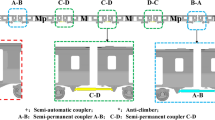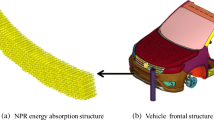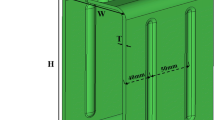Abstract
To improve the crashworthiness of vehicles, the crashworthiness of the vehicle structure itself has to be optimised. Through the collision analysis of a certain high-speed train, this research found that the front-end structure is most important in the crashworthiness optimisation design of the vehicle; the constitutive material models required for this numerical simulation of an entire vehicle were obtained by performing loading tests at different strain rates; according to the highly non-linear characteristics of the ensuing structural deformation under impact loading, this research used specific energy absorption (SEA) as an objective function to construct a multi-parameter optimisation model of the front-end structure of the vehicle . Based on this, the optimisation analysis was conducted. In the optimisation, the optimal SEA value (3.6988 kJ/kg) of the structure is obtained by 130-step iteration using a modified method of feasible directions (MMFD)—a gradient optimisation method; the optimal value obtained after 101 iterations by applying a direct search method—Hooke-Jeeves (HJ) algorithm is 3.6454 kJ/kg; and the optimal value acquired after 192 iterations of a global optimisation method—adaptive simulated annealing (ASA)—is 3.6132 kJ/kg. Moreover, the optimum results were validated by collision analysis of the optimal structure using a MMFD model. The variation analysis of the structural SEA with each variable show that the optimisation model is able to extend the range of each design variable.








Similar content being viewed by others
References
Alexander JM (1960) An approximate analysis of the collapse of thin cylindrical shells under axial loading. Q J Mech Appl Math 13(1):10–15
Ashtari P, Barzegar F (2012) Accelerating fuzzy genetic algorithm for the optimization of steel structures. Struct Multidiscip Optim 45(2):275–285
Cengiz B, Emin S, Sureyya EB, Fatih A, Toprak T, Mugan A (2011) Railroad passenger car collision analysis and modifications for improved crashworthiness. Int J Crashworthiness 16(3):319–329
Chen SY (2001) An approach for impact structure optimization using the robust genetic algorithm. Finite Elem Anal Des 37(5):431–446
Eom Y, Yoo K, Park J, Han S (2011) Reliability-based topology optimization using a standard response surface method for three-dimensional structures. Struct Multidiscip Optim 43(2):287–295
Forsberg J, Nilsson L (2006) Evaluation of response surface methodologies used in crashworthiness optimization. Int J Impact Eng 32(5):759–777
Gao G, Dong H, Tian H (2014) Collision performance of square tubes with diaphragms. Thin-Walled Struct 80:167–177
Gao GJ, Tian HQ (2007) Train’s crashworthiness design and collision analysis. Int J Crashworthiness 12(1):21–28
Ghamarian A, Zarei H (2012) Crashworthiness investigation of conical and cylindrical end-capped tubes under quasi-static crash loading. Int J Crashworthiness 17(1):19–28
Haghi Kashani M, Shahsavari Alavijeh H, Akbarshahi H, Shakeri M (2013) Bitubular square tubes with different arrangements under quasi-static axial compression loading. Mater Des 51:1095–1103
Hallquist JO (2006) LS-DYNA theory manual. Livermore Software Technology Corporation, California
Hong W, Fan HL, Xia ZC, Jin FN, Zhou Q, Fang DN (2014) Axial crushing behaviors of multi-cell tubes with triangular lattices. Int J Impact Eng 63:106–117
Hou S, Han X, Sun G, Long S, Li W, Yang X, Li Q (2011) Multiobjective optimization for tapered circular tubes. Thin-Walled Struct 49(7):855–863
Hou S, Li Q, Long S, Yang X, Li W (2007) Design optimization of regular hexagonal thin-walled columns with crashworthiness criteria. Finite Elem Anal Des 43(6–7):555–565
Hou S, Li Q, Long S, Yang X, Li W (2008) Multiobjective optimization of multi-cell sections for the crashworthiness design. Int J Impact Eng 35(11):1355–1367
Hou S, Li Q, Long S, Yang X, Li W (2009) Crashworthiness design for foam filled thin-wall structures. Mater Des 30(6):2024–2032
Jiang ZY, Gu MT (2010) Optimization of a fender structure for the crashworthiness design. Mater Des 31(3):1085–1095
Lanzi L, Airoldi A, Chirwa C (2009) Application of an iterative global approximation technique to structural optimizations. Optim Eng 10(1):109–132
Lanzi L, Castelletti LML, Anghileri M (2004) Multi-objective optimisation of composite absorber shape under crashworthiness requirements. Compos Struct 65(3–4):433–441
Park C, Joh C, Kim Y (2009) Multidisciplinary design optimization of a structurally nonlinear aircraft wing via parametric modeling. Int J Precis Eng Manuf 10(2):87–96
Redhe M, Giger M, Nilsson L (2004) An investigation of structural optimization in crashworthiness design using a stochastic approach. Struct Multidiscip Optim 27(6):446–459
Rikards R, Abramovich H, Kalnins K, Auzins J (2006) Surrogate modeling in design optimization of stiffened composite shells. Compos Struct 73(2):244–251
Sakata S, Ashida F, Zako M (2003) Structural optimization using Kriging approximation. Comput Methods Appl Mech Eng 192(7–8):923–939
Song J (2013) Numerical simulation on windowed tubes subjected to oblique impact loading and a new method for the design of obliquely loaded tubes. Int J Impact Eng 54:192–205
Song J, Guo F (2013) A comparative study on the windowed and multi-cell square tubes under axial and oblique loading. Thin-Walled Struct 66:9–14
Suchao X, Hui Z (2015) Analysis and optimisation of parameters influencing the out-of-plane energy absorption of an aluminium honeycomb. Thin-Walled Struct 89:169–177
Suchao X, Hui Z, Junjie Z, Yicheng Z (2013) Energy-absorption forecast of thin-walled structure by GA-BP hybrid algorithm. J Cent South Univ 20(4):1122–1128
Tang ZL, Liu ST, Zhang ZH (2013) Analysis of energy absorption characteristics of cylindrical multi-cell columns. Thin-Walled Struct 62:75–84
Xu FX, Sun GY, Li GY, Li Q (2014) Experimental study on crashworthiness of tailor-welded blank (TWB) thin-walled high-strength steel (HSS) tubular structures. Thin-Walled Struct 74:12–27
Zarei H, Kroger M (2008) Optimum honeycomb filled crash absorber design. Mater Des 29(1):193–204
Zhu P, Zhang Y, Chen GL (2011) Metamodeling development for reliability-based design optimization of automotive body structure. Comput Ind 62(7):729–741
Acknowledgments
This research was undertaken at the Key Laboratory for Traffic Safety on Track of the Ministry of Education, Central South University, China. The authors gratefully acknowledge the support from the National Natural Science Foundation of China (Grant nos. 51405516, U1334208), the support from the Shenghua Yu-ying Talents Program of the Central South University the support from the Shenghua Yu-ying Talents Program of the Central South University and the support from the Science and Technology Program for Hunan Provincial Science and Technology Department (Grant no. 2013GK2001). The author thanks Dr. Tanghong Liu for his calculation about the static stress of the crashworthiness train. The author also thanks Dr. Ping Xu for his support in material experiments of the car-body structure.
Author information
Authors and Affiliations
Corresponding author
Rights and permissions
About this article
Cite this article
Xie, S., Liang, X., Zhou, H. et al. Crashworthiness optimisation of the front-end structure of the lead car of a high-speed train. Struct Multidisc Optim 53, 339–347 (2016). https://doi.org/10.1007/s00158-015-1332-y
Received:
Revised:
Accepted:
Published:
Issue Date:
DOI: https://doi.org/10.1007/s00158-015-1332-y




